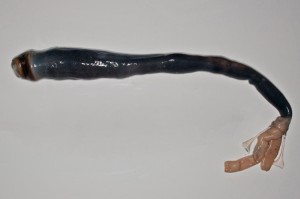Shapely Shipworms–They Live!
Friday, May 12th, 2017May 12, 2017
Last month, scientists in the Philippines found the first living specimens of giant, bizarre, and slimy shipworms. Until then, only fossilized remains of shipworms had been found. These remains usually consisted of a long, white, calcium carbonate shell left behind after the animal had bored deeply into wood (especially wood on piers or ships, hence the name) and eventually died. These rare and reclusive creatures, which feed on the wood, had never been found alive, but scientists knew they were out there somewhere.

A sleek, slimy giant shipworm waits patiently for examination in a laboratory on the south Philippine island of Mindanao in April 2017. Credit: © Marvin Altamia, Marine Science Institute
Shipworms are not worms, but rather bivalve (hinge-shelled) mollusks related to clams and mussels. In fact, young shipworms look like tiny clams and move about freely. As they develop, however, they begin their curious adulthood by attaching themselves to wood (usually) and beginning to bore a tunnel. They dig deeper as they grow older, and line the tunnels with a calcium carbonate shell. Fully grown shipworms are, on average, about the size of a baseball bat, but some of these critters can reach 6 feet (1.8 meters) in length. Shipworms do not do much else. They sustain themselves by drawing in water with tubelike organs called siphons. The water is drawn in through one siphon, pushed through the shipworms’s gills, and finally expelled out the other.
These first-ever live shipworm specimens were not found in wood, where their shell remains are so often found, but rather in a shallow, murky lagoon in the Philippines. Apparently, these unusual marine creatures will screw themselves into dense mud—areas of rich marine sediment—as well as wooden piers and ships.
The live shipworms surprised scientists with their choice of lodging, but there was still more to learn. The color of the animal (without its shell) is not what the scientists expected. Instead of being grayish, tan, pink, brown, or light beige (like most other bivalve mollusks), the shipworm is gunmetal black. The giant shipworm is also much more muscular than any other bivalve the scientists have studied. But one of the most unique new things learned about the giant shipworm is its diet. Rather than relying on decaying wood for food, these lagoon shipworms use bacteria in their gills to create energy from an extremely poisonous gas called hydrogen sulfide that is in the seawater. This energy is then used to turn carbon dioxide into nutrients for the shipworm. This rare ability to form energy from chemical reactions rather than from light (as in photosynthesis) is called chemosynthesis. It allows shipworms to survive in such harsh environments as muddy lagoon bottoms or hydrothermal vents on the ocean floor.
To Dan Distel of Northeastern University’s marine science center, the shipworm discovery is akin to finding a living dinosaur, because previous shipworms had only been known by their fossils. Distel co-wrote a study on the newly found shipworms published recently in the journal PNAS (Proceedings of the National Academy of Science). To British biologist Simon Watt, president of the semiserious Ugly Animal Preservation Society, the giant shipworm “might well be monstrous, but that does not mean that it isn’t marvelous.”


